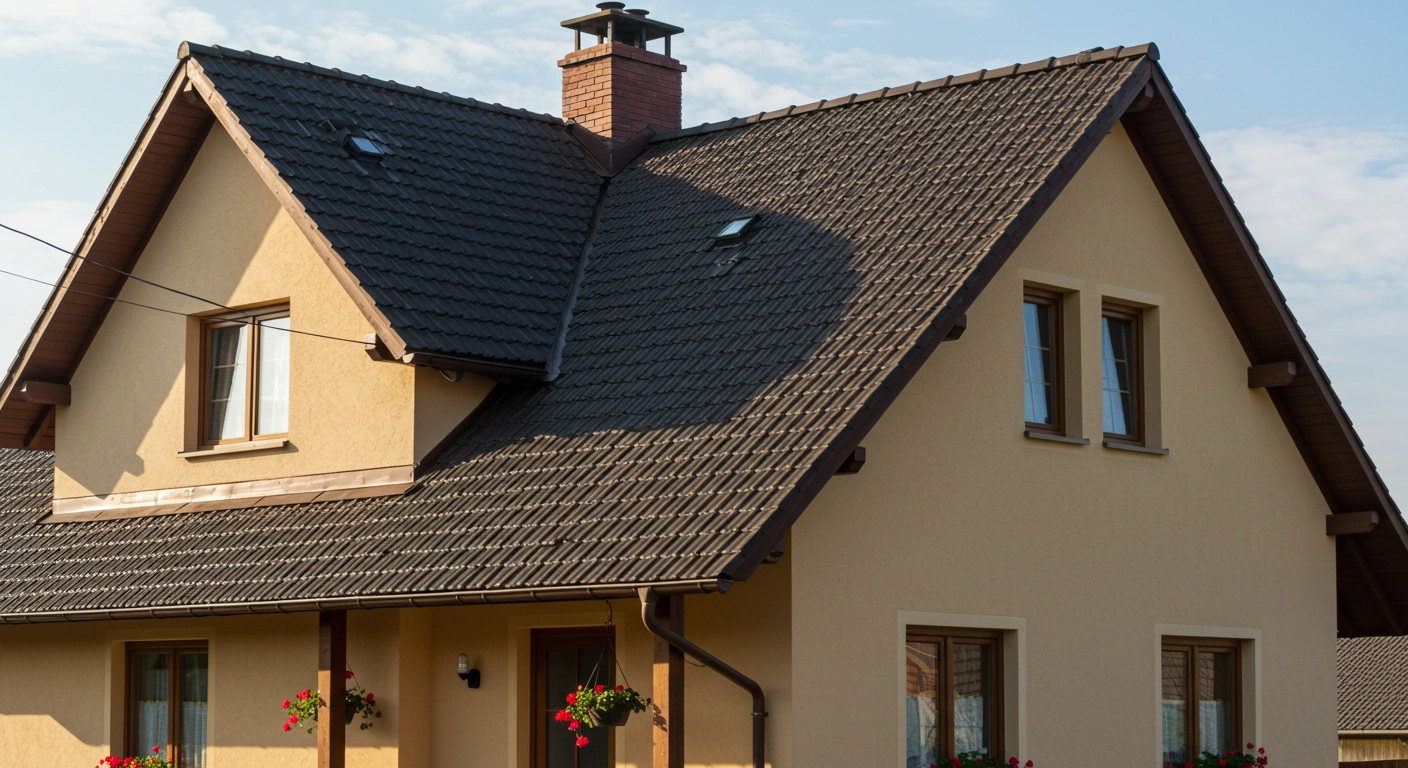In Arizona, Utah, and SoCal, the elements don’t take breaks. Sun, wind, flash floods, they hit your roof from all sides, year-round. And no, “I’ll deal with it next season” isn’t a strategy. That’s how small issues snowball into damage you can’t ignore.
At Real Roofing, we believe long roof life isn’t luck. It’s maintenance. It’s knowing what to watch for. It’s acting early, before water, time, and heat do their worst. This guide breaks down what matters, what doesn’t, and how to add serious years to your roof without wasting money on gimmicks.
⛔ Know What You’re Working With
How Long Does a Roof Last?
Not all roofs are built equally. Some materials are in it for the long haul. Others are just biding their time.
✔ Asphalt Shingles: Affordable and everywhere. With regular upkeep, you’ll get 15–20 years out of them. Push it further, and you’re playing roulette.
✔ Clay & Terracotta Tile: Built for heat. They handle the Arizona sun like nothing else. Clean them, seal them, and they’ll last 50+ years without blinking.
✔ Metal roofing: Reflects heat, shrugs off fire. 40–70 years is standard if it's installed right and kept clear of debris. Dents are your only real enemy.
✔ Wood Shakes: Look good, age fast. Expect 20–25 years, but only if you stay on top of cleaning, sealing, and pest control.
✔ Slate & Stone: Lasts a lifetime and then some, up to 100 years. Heavy as hell, though. Not ideal unless your home was built to carry the load.
✔ Flat Roofs (Commercial or Modern Builds): Lifespan depends entirely on maintenance. Ponding water, weak drainage, and neglect? That’s how you kill them early.
What Wears a Roof Down Faster Than Time
It’s not just age that breaks a roof. It’s what you don’t do about the stuff that happens along the way.
✔ Sun Exposure: UV cooks materials. Shingles curl. Sealants dry up. Tile cracks.
✔ Standing Water: Clogged gutters or poor slope = water that seeps into every weak point.
✔ Moss & Debris: They trap moisture and rot your roof from the top down.
✔ Improper Ventilation: If heat or moisture gets trapped inside, materials break down from below.
✔ Trees & Overhangs: Dropped branches, constant shade, pest access, nothing good comes from an overgrown roofline.
✔ Shoddy Repairs: Bad patch jobs invite more damage, not less. One wrong product or skipped step, and you’re back to square one.
Get familiar with what’s overhead and you'll find yourself paying less.
⛔ Routine Maintenance That Pays Off
Roof care isn’t complicated, but it’s the stuff most people skip until water starts pouring through the ceiling. Smart maintenance doesn't take long, doesn’t cost much, and buys you years of peace.
What to Inspect and When
Twice a year, at minimum. Spring and autumn. After any major storm? Make that three.
Here’s what you look for:
✔ Cracked or curled shingles
✔ Rusted flashing
✔Loose or missing tiles
✔ Pooling water (especially on flat roofs)
✔ Debris buildup, especially in valleys and around chimneys
✔ Discolored spots or sagging lines on ceilings or attic boards
Walk the perimeter with binoculars if you can’t safely access the roof. Or call in a pro for a full surface check, inside and out. Our team handles detailed roof inspections that go beyond the obvious. We catch issues before they show up on your drywall.
Clean It or Kill It Early
Leaves, dust, and roof grime may seem harmless until they trap moisture and chew through your structure.
✔ Gutters: Keep them clear. Clogs lead to water backup, soaked fascia, and rot.
✔ Moss or Algae: Clean it gently with a soft brush and eco-safe cleaner. Skip the pressure washer unless you want to strip material or force water under shingles.
✔ Roof Surface: Sweep off branches and debris regularly, especially after storms. Your roof isn’t a storage shelf for tree junk.
Looks aren’t the priority; structure is. Clean roofs last longer because they dry faster, weigh less, and don’t give pests a foothold.
Trim Your Surroundings
Overhanging branches are a slow-motion wrecking ball.
✔ They drop leaves that clog drains.
✔ They shade areas, trapping moisture.
✔They create runways for rats, squirrels, and insects.
Keep limbs trimmed back at least 6 feet (1.83 m). Bonus: it makes storms less risky and inspections easier.

⛔ Act Fast on Small Damage
Letting a leak “ride out the season” is how homeowners end up replacing drywall, insulation, framing, and paint. Small damage doesn’t stay small, and water doesn’t forgive procrastination.
Catch the Signs Early
The warning signs show up before the damage does. Look for:
✔ Brown water spots on ceilings or walls
✔ Curling shingles or exposed nail heads
✔ Bubbling paint or soft drywall
✔ Rust streaks near vents or flashing
✔ Sagging spots or strange smells in the attic
If you see any of these, stop reading and start patching or call us in.
Patch What You Can. Don’t Ignore the Rest.
Some jobs are DIY-friendly:
✔ Sealants for flashing or nail holes
✔ Re-caulking around vents
✔ Temporary patches with roof tape or tarps
But if you’ve got rot, sagging, cracked tile, or a flashing system that looks like it was installed drunk, get a pro.
At Real Roofing, we deal with both quick fixes and the jobs other contractors messed up. We don’t wait for damage to spread, and neither should you.
⛔ Smart Upgrades That Add Years
Some roofs last longer because they’re built better. Others last longer because the people living under them made smarter decisions before things got bad. These upgrades don’t need to be flashy. They need to work and keep working.
Ventilation and Insulation
Roofs trap heat. Without proper ventilation, that heat cooks your materials from the inside out. Shingles warp. Underlayment dries up. In winter, moisture builds and mold finds a home.
What you need:
✔ Intake vents (usually near the soffit)
✔ Exhaust vents (usually on the ridge or high point)
✔ Quality attic insulation to keep the temperature consistent and reduce material stress
Ventilation setups aren’t one-size-fits-all. What works for Phoenix doesn’t cut it in Park City. Our team tailors it to your climate, because guesswork ruins good roofs.
Protective Coatings and Sealants
Roof coatings are like giving your structure a second skin. They reflect UV, repel water, and seal up small vulnerabilities before they turn into open wounds.
Ideal for:
✔ Metal roofs (to stop rust and reflect heat)
✔ Tile roofs (to reduce cracking and moss growth)
✔ Flat roofs (to guard against ponding and membrane degradation)
Reapply every few years. It’s cheaper than replacing entire sections. We use coatings that do the job right, no trendy junk, no plastic paint posing as protection.
We help homeowners make the call when it’s time to invest in long-term durability, not band-aids.
⛔ Work With Pros Who Know Your Region
You don’t want a generalist with a pickup and a ladder. You want someone who’s been on roofs in your zip code, who’s worked through the heat, wind, hail, and dust.
Local Knowledge Matters
Roofs fail differently in each region:
✔ Arizona? UV damage and cracked sealants
✔ Utah? Snow load, freeze-thaw cycles
✔ Coastal SoCal? Salt corrosion, wind-lift ris
We’ve handled every one. We know the weak spots, the usual suspects, and the fixes that hold up five years down the line, not just five minutes after inspection.
Licensing and insurance are just the start. Look for a crew that works clean, shows up when they say they will, and leaves nothing behind but solid work.
Maintenance Plans That Save Money
Inspections don’t cost much. Emergencies do.
That’s why we offer seasonal maintenance plans, tuned to your region, your roof type, and your risk factors. No random charges, no bloated contracts. Just service that keeps you ahead of leaks and repairs that fix the root problem.
These aren’t “nice to haves.” They’re what keep you off a ladder in the middle of July with a half-soaked attic and a maxed-out budget.
⛔ Quick Habits That Make a Big Difference

You don’t need to be on the roof every weekend. But a few light habits? They’ll save you thousands and stop headaches before they start.
Keep It Simple: Monthly Check Routine
Once a month, especially after a windy night or heavy rain, take ten minutes to:
✔ Walk the perimeter.
✔ Look for missing shingles, new stains, and debris piles.
✔ Check your ceilings inside for water spots or discoloration.
✔ Use binoculars if needed; no need to play acrobat.
This isn’t about full inspections. It’s about spotting changes early enough to act.
Be Smart About Cleaning and Safety
✔ Use soft brooms or low-pressure hoses to clear leaves and gunk.
✔ Wear non-slip shoes if you’re climbing up.
✔ Never clean wet roofs or climb in high winds.
✔ If something looks risky, don’t do it; call someone who knows what the hell they’re doing.
The goal isn’t to turn you into a roofer. It’s to keep you from needing one every year.
Long Roof Life Doesn’t Happen by Accident
Roofs fail when they’re ignored. They last when you stay ahead, spotting trouble early, fixing what matters, and not waiting for leaks to teach you a lesson.
You don’t need a dozen tools or a contractor on speed dial. What you require is consistency. Inspect it. Clean it. Fix the small stuff before it grows teeth. And when something’s outside your wheelhouse, get someone who knows what they’re doing.
At Real Roofing, we work with homeowners who want their roof to last, not just hold on. Whether it’s a seasonal checkup, a coating job, or a full material upgrade, we’ve got the local experience to keep your home covered the right way.
Get in touch with us here, and we’ll help you get ahead of the next storm, not patch it after the fact.
⛔ FAQs: What Homeowners Usually Ask Us
How do I know if my last roof job was done properly?
Check the details. Straight lines. Tight flashing. No exposed nails. If you see caulk slathered everywhere or materials lifting within a year, someone cut corners. Call us, we’ll take a proper look.
Is drone inspection a gimmick or worth it?
Drone inspections are legit for spotting hard-to-see damage or getting a bird’s-eye view without stepping on fragile areas. We use them where it makes sense, not as a replacement for hands-on checks.
What’s the worst roofing mistake homeowners make?
Waiting too long to fix something obvious. A $30 tube of sealant now saves you from a $3,000 ceiling collapse later.
Can I re-roof over the old one to save money?
In some states, yes. But it traps heat, hides rot, and shortens lifespan. We don’t recommend it unless your structure’s solid, and it’s cleared by code.




